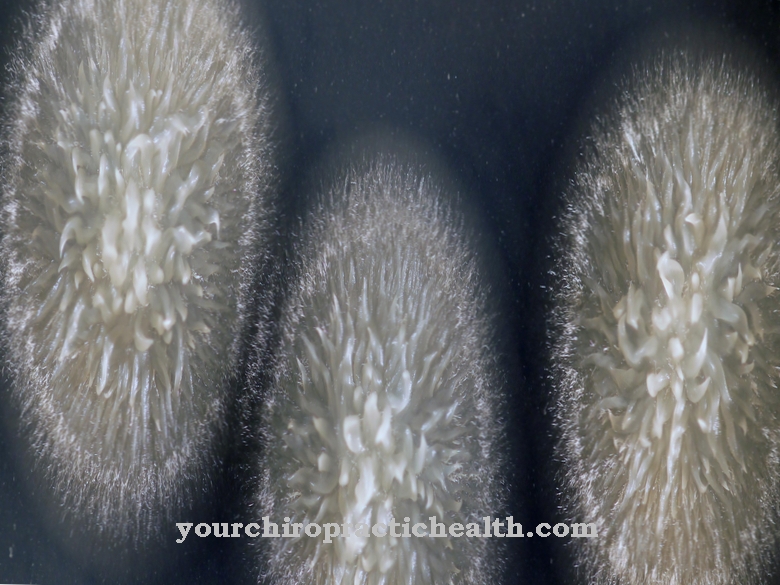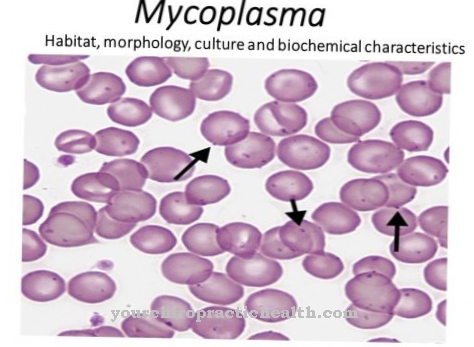Mycoplasma fermentans is a parasitic microorganism in the form of a bacterium that has already been detected in various regions of the human body. It belongs to the class of Mollicutes, specifically to the family of Mycoplasmataceae.
What is Mycoplasma fermentans?
Mycoplasma fermentans was first discovered in 1952 by Ruiter and Wentholt while investigating a genital infection. Two years later it could be proven again by Edward, who gave the bacterium its current name in 1955. Since then, four different strains of the species have been extensively studied and characterized.
Mycoplasma fermentans lives as a parasite in the human body, which acts as its sole host and thus as a food source for cholesterol, sugar and various amino acids. Since a pathogenic effect of the bacterium is still controversial, Mycoplasma fermentans is sometimes only referred to as commensals or paraphages - life forms that live at the expense of their host, but do not harm it in return.
Mycoplasma fermentans' primary habitat is the genital area, where it attaches to the surface of cells from the epithelium, a basic tissue without blood vessels. In addition, its occurrence in the respiratory and urinary tract is confirmed.
Occurrence, Distribution & Properties
The main characteristic of Mycoplasma fermentans is the lack of a cell wall. The bacterium is only surrounded by a lipoprotein membrane and therefore cannot be stained with the classic Gram stain for visualization in light microscopy. Likewise, the polymer capsule made of sugar or amino acids, which otherwise frequently occurs in bacteria, is also absent. It usually serves to protect against the human immune system. Mycoplasma fermentans does not form spores either, which means that no spore wall, which is often otherwise very thick, can arise for protection. The osmotic resistance of the bacterium is therefore quite low.
Due to the lack of cell walls, the penicillins used nowadays are ineffective against Mycoplasma fermentans, because the antibiotics are designed exclusively to block the synthesis of the bacterial cell walls. The same applies to the enzyme lysozyme, which occurs in the body and plays a role in the human immune system by breaking down the cell walls of pathogenic bacteria. On the other hand, so-called macrolides, which disrupt the bacterium's protein synthesis and thus inhibit its growth, can be used effectively. Quinolones, which attack the bacterial genome, are an alternative to this.
With a size of only 0.1 to 0.6 micrometers, Mycoplasma fermentans is one of the smallest bacteria that is capable of multiplying independently. It has an active metabolism and is demonstrably able to convert or ferment sugars such as glucose or fructose, but also various amino acids using enzymes. However, Mycoplasma fermentans is not capable of some metabolic processes. An example of this is the lack of cholesterol biosynthesis and the resulting need to take in cholesterol from food.
Mycoplasma fermentans has both RNA and DNA, but the genome is very small. It appears in a circular shape and is now completely known in its entirety. There are just over a million base pairs in total.
Mycoplasma fermentans has special surface molecules to adhere to the epithelial cells of humans. However, these are not the thread-like extensions (pili) that are otherwise common in bacteria. No oxygen is required for subsequent growth. However, Mycoplasma fermentans is facultatively anaerobic, i.e. able to grow even in the presence of oxygen. A temperature of 37 degrees Celsius has been proven to be the ideal growth condition. In this regard, the bacterium is optimally adapted to life in humans.
Illnesses & ailments
Previous studies have shown that Mycoplasma fermentans is not a symbiont, but a one-sided beneficiary with humans as the host organism. However, the extent to which the bacterium has a pathogenic, i.e. disease-causing effect is still unclear. Several studies have already been carried out in this regard, but they did not produce any clear evidence for the connection between the occurrence of Mycoplasma fermentans and certain diseases. Further studies of this kind have not yet been carried out, which means that the importance of this bacterium in the human body remains uncertain.
Nevertheless, Mycoplasma fermentans is still detected in pathological examinations of certain diseases and is consequently associated with them. The bacterium makes it appear to be a kind of support for the actual pathogen. In this regard, there is often talk of a co-infection or a coupling with another infection, so that an intensification or an acceleration of the course of the infection is brought about.
Mycoplasma fermentans is mainly associated with HIV infections, as autopsies have already proven the simultaneous occurrence of the bacterium. But there should also be a reference to certain respiratory diseases, rheumatic complaints or arthritis.
Often symptoms of inflammation caused by Mycoplasma fermentans are tiredness and muscle pain. A connection to diseases such as fibromyalgia or chronic fatigue syndrome, or CFS for short, is therefore obvious, but has not been proven. Even in the case of inflammation in the preferred habitat, the genital area, no evidence has been provided as to the cause.

























.jpg)


